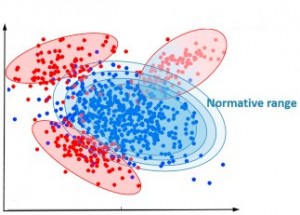This post is also available in Dutch.
Making a clear-cut between a healthy person and one with a mental disorder is very difficult. Novel techniques may help us to redefine mental health and disorders in a way that better reflects a variable and complex human character.
Illustrated is a new way of looking at mental disorder, defined as a deviation from a normative range along different behavioural and biological domains. While blue dots represent individuals that fall within this normative range, red dots show individuals that fall out of it along different domains. This illustration has been taken from Dr. A. Marquand’s paper (1) with slight modifications and the permission of the author.
Current standards and new approaches in defining mental health and disorder
Today, a psychiatric diagnosis is guided by manuals that contain check lists of symptoms and categories of disorders. The latest revision of the most famous manual is known as Diagnostic Statistical Manual (DSM)-5,which provides a common language for clinicians to describe mental disorders. Although, these categories can reliably be determined, they do not provide knowledge about the underlying biological processes behind a specific disorder. Without this information the development of appropriate and efficient novel treatments are limited. Therefore, scientists are working on biologically more relevant categories for mental disorder. The National Institute of Mental Health in America has started a research domain criteria (RDoC) initiative, in which scientists and clinicians are encouraged to think of mental disorders as deviations from normal processes. Let’s illustrate this: Recall back to when you were a student in school, no one was able to remain fully concentrated throughout an entire lesson. Turns out, there is great variability across individuals for this ability. According to the RDoC imitative, quantifying different cognitive and biological domains provides a fuller picture of a variable and complex human character, which may open up new ways of understanding mental disorder in future.
Health and disorders of the mind or how can we define a norm for mental processes?
To identify a norm for behaviour in a particular situation, we accumulate information over time and deem the most common behaviour as typical in that situation. For example, you would probably not think of going to the supermarket naked. If you would, you would be an abnormal customer. Normal behaviour can be identified by counting how often a specific behaviour occurs in a particular situation.
The quantification of mental processes is different, however. They cannot be observed or touched, they have no substance. Therefore, it is difficult to directly quantify (and count) them. Rather, we study them indirectly using, for example, neuroimaging methods or by relying on introspection. Large datasets with different biological and behavioural information may be helpful to more reliably approximate mental processes in health and disease. Some of this work is currently being conducted in scientific consortia such as IMAGEMEND. These datasets require new analytic methods to automatically estimate the degree to which a particular process can be considered as normal. Big efforts are being made by a group of researchers here at the Donders Institute, led by Dr. A. Marquand, who recently published an article in the scientific journal ‘Biological Psychiatry’ (2). This work contributes toward quantifying mental disorder as a deviation from both behavioural and biological norms. That said, falling out of the norm, does not necessarily mean that you are sick. However, abnormality may be a key to find causative behavioural and biological mechanisms in those individuals that suffer.
Christina Isakoglou was born in Greece and is studying Neuroscience at the Donders Institute. She has a background in computer science and is fascinated by applying and developing novel methods to better understand diseases of the brain.
Thomas Wolfers was born in Germany and is a PhD student in Neuroscience at the Donders Institute and the department of human genetics at the Radboud University. In his PhD he investigates psychiatric disorders using pattern recognition techniques.
Edited by Roselyne
References
1. Marquand AF, Wolfers T, Mennes M, Buitelaar J, Beckmann CF (2016): Beyond lumping and splitting: a review of computational approaches for stratifying psychiatric disorders. Biol Psychiatry Cogn Neurosci Neuroimaging. . doi: 10.1016/j.bpsc.2016.04.002.
2. Marquand AF, Rezek I, Buitelaar J, Beckmann CF (2016): Understanding heterogeneity in clinical cohorts using normative models: beyond case control studies. Biol Psychiatry. . doi: 10.1016/j.biopsych.2015.12.023.

